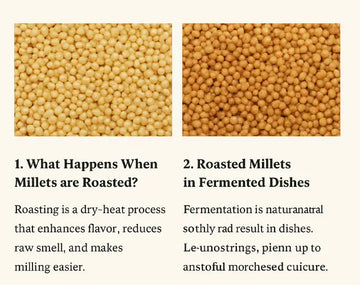Introduction

In recent years, millets have gained popularity as a nutritious and sustainable alternative to conventional grains. As the world faces increasing environmental challenges and a growing demand for organic foods, millets offer an array of benefits for our health and the planet. This article will explore the nutritional advantages of nine millets, including Kodo, little, foxtail, browntop, barnyard, finger millet, jowar/sorghum, pearl millet, and proso millet, as well as their environmental impact and their role in promoting a sustainable future. In recognition of their importance, the United Nations has declared 2023 as the International Year of Millets.
Understanding Millets
Millets are a group of small-seeded grasses that predominantly grow in semi-arid regions of Asia and Africa. They are known for their hardiness, rapid growth, and ability to thrive in poor soil conditions. Millets have been an essential staple food in many traditional diets for thousands of years, and they are now gaining recognition for their nutritional and environmental benefits.
There are several types of millets commonly consumed, including Kodo, little, foxtail, browntop, barnyard, finger millet, jowar/sorghum, pearl millet, and proso millet. Each variety has its unique characteristics, flavor, and uses in different cuisines. Some millets, like pearl and finger millets, are more widely grown and consumed, while others, such as foxtail and barnyard millets, are primarily cultivated in specific regions or countries.
The history of millets dates back to over 5,000 years ago, with evidence of their cultivation found in ancient China, India, and Africa. Millets have played a crucial role in the development of early agricultural societies, providing a reliable source of food and nutrition in areas with harsh climates and limited resources. Today, millets continue to be a vital food source for millions of people worldwide, particularly in developing countries, where they contribute to food security and sustainable agriculture practices.
Nutritional Benefits of Millets
Millets offer a wealth of nutritional benefits, making them a valuable addition to any diet. They are rich in fiber, high in protein, and packed with essential vitamins and minerals, such as B vitamins, iron, magnesium, phosphorus, and potassium. This impressive nutrient profile contributes to several health benefits associated with millet consumption.
Adding millets to your diet can improve digestion, thanks to their high fiber content, which aids in maintaining regular bowel movements and preventing constipation. The fiber in millets can also promote heart health by helping to lower cholesterol levels and reduce the risk of cardiovascular diseases. Furthermore, millets have a low glycemic index, making them an ideal choice for managing diabetes and maintaining stable blood sugar levels.
Millets can also contribute to weight management, as their high fiber and protein content help to increase satiety and reduce hunger. In addition, millets are beneficial for bone health, as they are rich in calcium and other minerals that support strong and healthy bones.
One of the many advantages of millets is their versatility in cooking and recipes. They can be used to prepare a wide range of dishes, such as porridge, breads, pancakes, salads, and even desserts. This makes it easy to incorporate millets into your daily diet and enjoy their numerous nutritional benefits.
Millets and Environmental Sustainability
Millets are not only nutritious but also environmentally sustainable, making them an ideal choice for a greener future. They have low water and resource requirements, thanks to their drought-resistant properties. Millets can thrive in poor soil conditions with minimal irrigation, reducing the strain on water resources. Additionally, they require little to no fertilizers and pesticides, further reducing their environmental impact.
Beyond their resource efficiency, millets also offer benefits for soil health and biodiversity. Some millet varieties have nitrogen-fixing properties, which can improve soil fertility and reduce the need for chemical fertilizers. Moreover, millet fields provide habitats and food sources for pollinators and wildlife, supporting local ecosystems and promoting biodiversity.
Another advantage of millets is their adaptability to changing climate conditions. They are resilient to extreme temperatures and weather events, making them a valuable crop in regions facing increased climate variability. As global temperatures continue to rise and weather patterns become more unpredictable, millets have the potential to provide increased yields and contribute to food security in the face of climate change.
Economic and Social Impact of Millets
The cultivation of millets offers several economic and social benefits, particularly for small-scale farmers. Growing millets can result in lower production costs due to their minimal requirements for water, fertilizers, and pesticides. This makes millets an attractive crop for resource-limited farmers looking to diversify their income sources and reduce their reliance on expensive inputs.
In addition to their economic advantages, millets contribute to food security and community well-being by promoting locally-sourced food systems. By growing and consuming millets within the same region, communities can reduce their dependence on imported foods and strengthen their local economies. Furthermore, the cultivation of millets helps preserve traditional knowledge and cultural heritage, as these ancient grains have been an integral part of various cultures for thousands of years.
Lastly, the increased demand for millets encourages fair trade practices and ethical considerations within the agricultural industry. By ensuring fair prices for farmers and supporting environmentally-friendly production methods, consumers can contribute to a more sustainable and equitable food system that benefits both people and the planet.
Conclusion
In summary, millets offer a wide range of benefits for nutrition, environmental sustainability, and social impact. Their high nutritional content, low resource requirements, and adaptability to changing climate conditions make them a valuable food source for the future. By incorporating millets into our daily diets and supporting organic, sustainable practices, we can contribute to a healthier lifestyle and a more sustainable world.
We encourage you to explore and share information on millets and other sustainable food choices, in line with Organic Sphere's commitment to promoting a healthy and environmentally-conscious lifestyle. By making informed choices and embracing sustainable food options, we can work together to create a brighter and more sustainable future for our planet.





